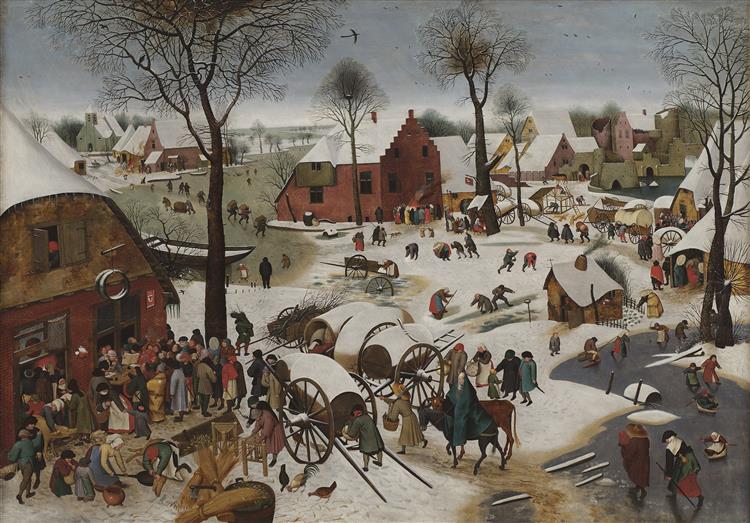Description
Pieter Brueghel the Younger's painting "The Census of Bethlehem" is a striking work that captures a moment of affliction and bureaucracy in a deeply human context. Executed in the style of the master Brueghel the Elder, of whom he was a noble follower and who left an indelible mark on the art of the Northern European Renaissance, this work offers a rich and complex view of daily life in Bethlehem during the census, often understood as an event of great historical and social significance.
Compositionally, the painting unfolds in a crowded outdoor scene, carefully structured in layers that guide the viewer’s gaze through a web of human actions. The use of subtle spatial perspective in the arrangement of characters and buildings, and the attention to detail in the various groups present, provides a sense of density and animation. The crowd, each individual, contributes to the visual narrative, conveying the sense of a community immersed in the context of the census. The action seems to be in constant motion, from the gathering of people to the registration, which calls upon the viewer to reflect on the weight of history that this scene carries.
The treatment of colour in this work is remarkable. Brueghel the Younger employs a vibrant yet nuanced palette, where earthy tones, deep blues and warm ochres predominate. This use of colour not only establishes a vivid and naturalistic atmosphere, but also acts to highlight the emotions of the characters, who are immersed in the anguish and, possibly, frustration of the census. The clothing of the characters is a visual statement of the different social strata, and in this sense, the artist sums up the complexity of the society of his time with great mastery.
The characters in the painting offer a varied representation of everyday life. Among the crowd, one can observe various expressions that convey different emotions: from the resignation of an old man holding his cane, to the impatience of a young man who seems to be claiming his turn at the register. The attention to the face, hands and body posture of these characters reflects a deep investigation into the human condition and social interaction in a time of tribulation. This ability to capture the emotional essence of the figures is a distinctive feature of Brueghel the Younger, who, although he continued the legacy of his father, also knew how to offer his own creative approach.
Furthermore, it is interesting to note that this work is not only a repetition of his father’s original, but also a reimagining that reflects the context and concerns of its time. During the 17th century, Flemish art experienced a revival in which everyday life began to be an increasingly relevant subject. Brueghel the Younger, in depicting the Census of Bethlehem, also encapsulates the tension between bureaucracy and popular life, a theme that has resonated throughout art history.
In conclusion, Pieter Brueghel the Younger’s “The Census of Bethlehem” is more than just a reproduction of a monumental work; it is a rich and complex exploration of human interaction and the fragility of social context. The meticulously woven composition and eloquent use of color, combined with the emotional depth of its characters, invite the viewer into a broader contemplation of the human condition and history. This ensures that, through technique and the life that pulsated in its brushstrokes, the work remains just as provocative and relevant today as it was in its time.
KUADROS ©, a famous painting on your wall.
Hand-made oil painting reproductions, with the quality of professional artists and the distinctive seal of KUADROS ©.
Painting reproduction service with satisfaction guarantee. If you are not completely satisfied with the replica of your painting, we will refund 100% of your money.

